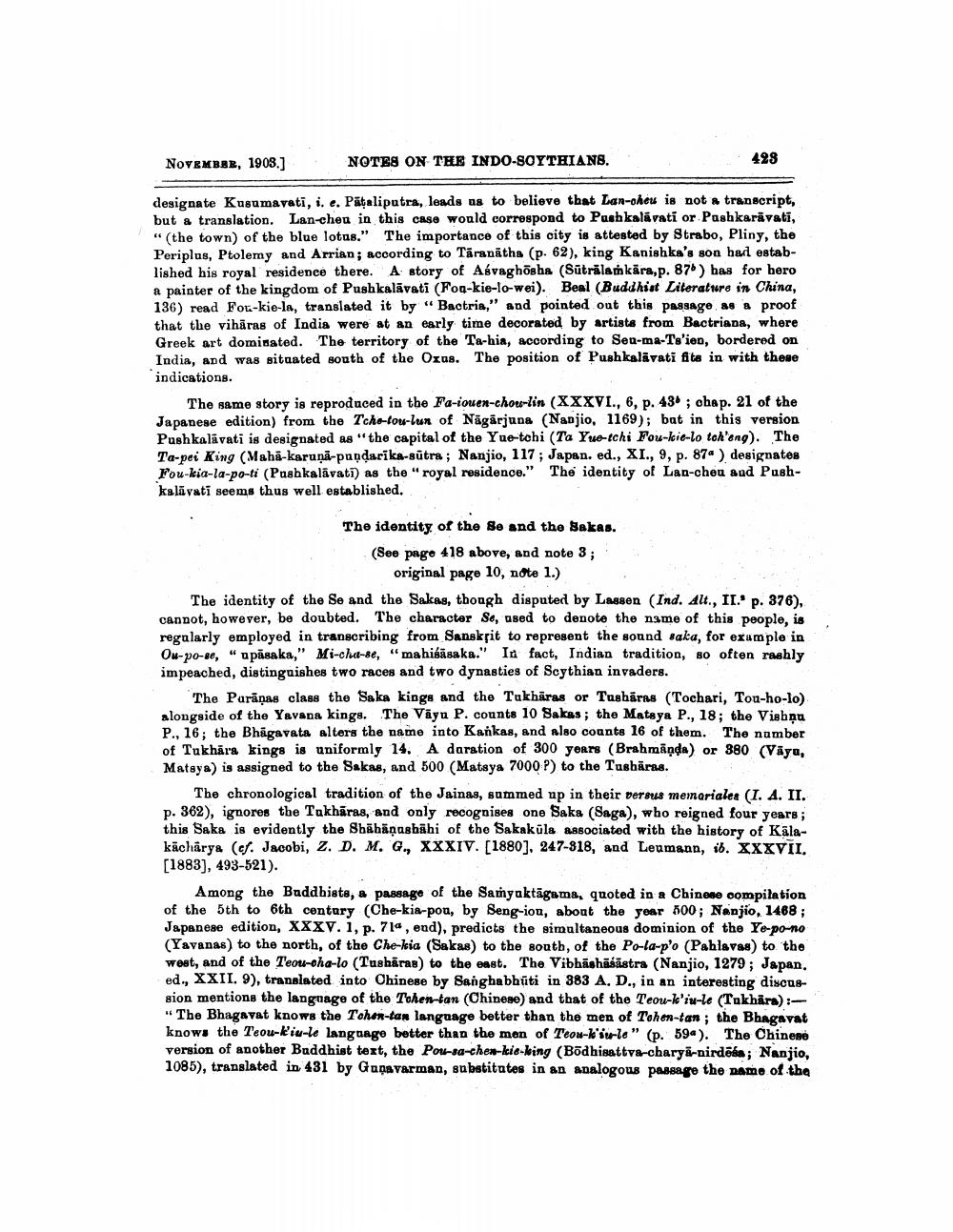________________
NOTES ON THE INDO-SOYTHIANS.
428
NOVEMBER, 1908.]
designate Kusumavati, i. e. Pataliputra, leads us to believe that Lan-oheu is not a transcript, but a translation. Lan-cheu in this case would correspond to Pushkalavati or Pushkaravati, "(the town) of the blue lotus." The importance of this city is attested by Strabo, Pliny, the Periplus, Ptolemy and Arrian; according to Taranatha (p. 62), king Kanishka's son had established his royal residence there. A story of Aávaghosha (Sutralam kāra, p. 876) has for hero a painter of the kingdom of Pushkalavati (Fon-kie-lo-wei). Beal (Buddhist Literature in China, 136) read Fot-kie-la, translated it by "Bactria," and pointed out this passage as a proof that the viharas of India were at an early time decorated by artists from Bactriana, where Greek art dominated. The territory of the Ta-hia, according to Seu-ma-Ts'ien, bordered on India, and was situated south of the Oxus. The position of Pushkalavati fits in with these indications.
The same story is reproduced in the Fa-iouen-chou-lin (XXXVI., 6, p. 43; chap. 21 of the Japanese edition) from the Tche-tou-lun of Nagarjuna (Nanjio, 1169); but in this version Pushkalavati is designated as "the capital of the Yue-tohi (Ta Yue-tchi Fou-kie-lo teh'eng). The Ta-pei King (Maha-karuna-pundarika-sūtra; Nanjio, 117; Japan. ed., XI., 9, p. 87") designates Fou-kia-la-po-ti (Pushkalavati) as the "royal residence." The identity of Lan-chen and Pushkalavatī seems thus well established.
The identity of the Se and the Sakas.
(See page 418 above, and note 3;
original page 10, note 1.)
The identity of the Se and the Sakas, though disputed by Lassen (Ind. Alt., II. p. 376), cannot, however, be doubted. The character Se, used to denote the name of this people, is regularly employed in transcribing from Sanskrit to represent the sound saka, for example in Ou-po-se, "upasaka," Mi-cha-se, "mahisasaka." In fact, Indian tradition, so often rashly impeached, distinguishes two races and two dynasties of Scythian invaders.
The Puranas class the Saka kings and the Tukharas or Tushāras (Tochari, Tou-ho-lo) alongside of the Yavana kings. The Vayu P. counts 10 Sakas; the Matsya P., 18; the Vishnu P., 16; the Bhagavata alters the name into Kankas, and also counts 16 of them. The number of Tukhara kings is uniformly 14. A daration of 300 years (Brahmanda) or 380 (Vaya, Matsya) is assigned to the Sakas, and 500 (Matsya 7000 P) to the Tushāras.
The chronological tradition of the Jainas, summed up in their versus memoriales (I. A. II. p. 362), ignores the Takharas, and only recognises one Saka (Saga), who reigned four years; this Saka is evidently the Shähäṇashahi of the Sakaküla associated with the history of Kalakacharya (cf. Jacobi, Z. D. M. G., XXXIV. [1880], 247-818, and Leumann, ib. XXXVII. [1883], 493-521).
Among the Buddhists, a passage of the Samyuktagama, quoted in a Chinese compilation of the 5th to 6th century (Che-kia-pou, by Seng-ion, about the year 500; Nanjio, 1488; Japanese edition, XXXV. 1, p. 71%, end), predicts the simultaneous dominion of the Ye-po-no (Yavanas) to the north, of the Che-kia (Sakas) to the south, of the Po-la-p'o (Pahlavas) to the west, and of the Teou-oha-lo (Tusharas) to the east. The Vibhashäsästra (Nanjio, 1279; Japan. ed., XXII. 9), translated into Chinese by Sanghabhuti in 383 A. D., in an interesting discussion mentions the language of the Tohen-tan (Chinese) and that of the Teou-k'iu-le (Takhara) :"The Bhagavat knows the Tohen-tan language better than the men of Tohen-tan; the Bhagavat knows the Teou-k'iu-le language better than the men of Teou-k'iule" (p. 59a). The Chinese version of another Buddhist text, the Pou-sa-chen-kie-king (Bodhisattva-charya-nirdesa; Nanjio, 1085), translated in 431 by Ganavarman, substitutes in an analogous passage the name of the




